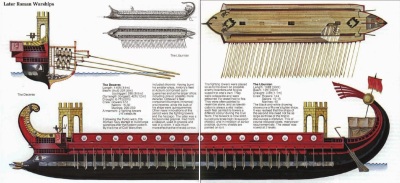After Actium, as we have seen, Augustus concentrated his ships at two bases, Misenum and Ravenna, to watch the western and eastern Mediterranean. These two ports continued to be the chief bases of the Roman fleets for three centuries or more. Under the Empire, the fleets had, we may think, not much to do. Little is heard about piracy or other seaborne hazards. The ships served to transport troops to new postings, and protect the grain supply to the city.
Detachments from both Misenum and Ravenna were based in Rome, to handle the awnings at theatres and amphitheatres there. The overall manpower of both fleets remained at a high level, with about 10,000 sailors at each base. Under Augustus and his immediate successors the fleets were commanded by equestrian officers, often ex-legionary tribunes, and later by freedmen of the Emperor’s household. But after AD 70 the commands were integrated into the equestrian civil service, and became two of the most senior posts; the Elder Pliny, encyclopaedist, naturalist and a senior procurator in the government service, was prefect of the fleet at Misenum when he lost his life in the eruption of Vesuvius in AD 79.18 Professional admirals in the Hellenistic mould, briefly renascent in the Civil Wars of the Late Republic, are not heard of again, nor (with very few exceptions) are the squadrons of the eastern dynasts; these were incorporated along with the kingdoms and principalities into the Roman system. Control of a fleet no longer required any professional skills in seafaring, or a particular interest in naval warfare; administrative competence was the only expertise demanded. Detached squadrons on the Rhine, Danube and the English Channel played a more serious role in the maintenance of security in the frontier context. Here again their commanders were equestrians in the course of a procuratorial career.
The fleets’ manpower was drawn from free-born provincials, like the auxiliaries; slaves were not used, as in popular modern tradition. The Ravenna fleet drew a substantial number of men from the Balkan provinces and Pannonia, the Misenum fleet from Sardinia, Corsica, Africa and Egypt. No experience of sailing, or a home on the coast, were deemed of special importance in the selection of men, any more than in modern navies. The men served 26 years (one year more than the legionaries and auxiliaries), receiving—like the latter —citizenship and regularisation of marriage on discharge. From the time of Vespasian sailors began to use Latin names, and this general improvement in status is marked also by the award, probably made under Domitian, of the title praetoria to both main fleets, indicating an acceptance of their role in the central defence of the Emperor’s position. The title matches the cohortes praetoriae of the imperial bodyguard. The civil war of AD 68–69 saw the creation of legio I Adiutrix from the fleet at Misenum, and legio II Adiutrix from Ravenna; the latter saw service under Agricola in Britain. The title Adiutrix indicates that they were envisaged at first as offering ‘Support’ or ‘Assistance’ to the regular forces. It seems that founder members of both legions remained non-citizens until discharge, but fresh drafts were drawn from the normal sources thereafter so that they were quickly assimilated.
After Actium we hear no more of legions serving on shipboard, presumably because the military presence of such heavily armed infantry was deemed no longer necessary.
